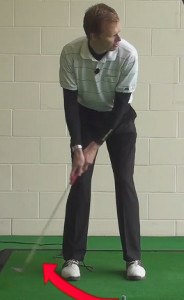
No doubt you’ve heard this statistic: 100 percent of putts that come up short do not go in the hole. It’s one of golf’s immutable laws, and one that most golfers run afoul of far too often. Of course, a putt that’s hit much too hard stands little chance of finding the bottom of the cup, too.
Getting the correct speed is the most important aspect of putting – yes, even more important than line. Fact is, the two factors are inseparable, yet we spend far more time worrying about the green’s break than we do working on the speed of our putts. Most three-putts occur not because we’re wide of the hole, but because we’ve left our first attempt far short or smashed it well past the cup.
Here are a few ways to improve your feel for speed:

- Practice with one hand: Your ability to control the putter plays a big part in feel. Using your left hand only, stroke several putts from close range (2-3 feet) until you get comfortable. Then move out another 3-5 feet and repeat, continuing until you’re 25 feet or more from the hole. Then switch to your right hand and start over.
- Use the “ladder drill”: Find an open spot on the practice green and stroke a putt 8-10 feet away, but not toward a cup. Try to hit the next putt three feet past the first one, and the next ball three feet beyond that. Keep it up until you can consistently hit your distance targets.
- Practice lag putts without reading the break: Putt from 30-40 feet using only your instinct for the line and speed. Hit just one ball at a time from any given spot so that the break of each putt is different.
On the day of a round, always spend a few minutes on the practice green to gauge the speed before teeing off. It’s every bit as crucial as warming up on the range.
Practicing distance control is crucial for improving your putting performance. Here are some effective methods to practice and enhance your distance control skills:
- Putting drills: Incorporate putting drills into your practice routine that specifically focus on distance control. For example:
- Lag putting: Set up a series of longer putts, such as 30 to 40 feet, and focus on getting the ball as close to the hole as possible without going past it. This drill helps you develop a feel for longer distances and trains your touch and speed control.
- Three-putt avoidance: Create a scenario where you have to putt from various distances and challenge yourself to avoid three-putting. This drill helps you learn to judge the speed and distance accurately to give yourself tap-ins for the next putt.
- Distance ladder: Set up a ladder of different putt lengths, such as 10, 20, 30, and 40 feet. Practice putting from each distance, aiming to get the ball within a specific zone around the hole. This drill helps you become comfortable with different distances and develop a consistent feel for each.
- Target practice: Place markers or tee pegs at different distances around the practice green. Practice hitting putts to these targets, focusing on getting the ball to stop close to the markers. This exercise helps you refine your distance control by visually and kinesthetically gauging the length of your strokes.
- Metronome or tempo training: Use a metronome or create a rhythmic counting pattern to develop a consistent tempo and stroke length. This helps you establish a reliable stroke that translates to better distance control. Practice putting to the beat or rhythm, focusing on maintaining a smooth, even-paced stroke.
- Visualization and feel: Develop a mental image of the desired putt length and the speed you want to achieve. Visualize the ball rolling along the intended path and gauge the distance based on your past experiences. Develop a sense of feel for different distances by practicing putting from various lengths and paying close attention to the outcome.
- Long-distance practice: Don't solely focus on short putts during practice. Incorporate longer putts into your routine to improve your distance control for different ranges. This helps you gain a better understanding of how the speed and distance of your stroke affect the roll of the ball.
- Keep a putting journal: Track your practice sessions and note the distances and results of your putts. This record allows you to monitor your progress, identify trends, and make adjustments to improve your distance control.
Remember, consistency and practice are key when it comes to distance control in putting. Dedicate regular time to these drills and exercises, and over time, you will develop a better sense of feel and touch, leading to improved distance control and ultimately better putting performance on the course.





